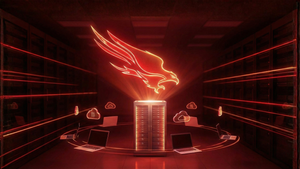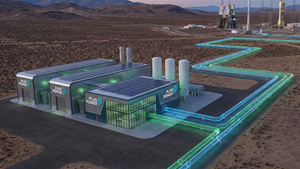PCE Inflation Accelerates to 2.7%, Igniting Concerns for Commodity Markets and Corporate Profits

Washington D.C., September 26, 2025 – The Personal Consumption Expenditures (PCE) price index, the Federal Reserve's preferred measure of inflation, recently accelerated to 2.7% year-over-year in August 2025. This uptick from 2.6% in July, and a steady core PCE at 2.9% (excluding volatile food and energy prices), signals persistent inflationary pressures that continue to hover above the Federal Reserve's long-term target of 2%. This development has sent ripples through financial markets, raising questions about the trajectory of interest rates and the future prices of key commodities like oil, natural gas, and metals.
The acceleration of headline PCE inflation to 2.7% is a critical indicator that the overall cost of living is rising, challenging the Federal Reserve's objective of restoring price stability. While the August figures were largely in line with market forecasts, preventing a dramatic market shock, they reinforced the notion of "sticky" inflation. This environment complicates the Fed's monetary policy decisions, especially after a recent 25 basis point rate cut, as it weighs the need to support a weakening labor market against the imperative to control inflation.
Detailed Coverage: The Persistent Inflationary Challenge
The PCE index, compiled monthly by the Bureau of Economic Analysis (BEA), is favored by the Fed over the Consumer Price Index (CPI) because it accounts for shifts in consumer spending patterns and covers a broader range of goods and services. The current 2.7% headline PCE rate marks its highest level since February 2025, following a gradual re-acceleration from 2.6% in June and July. Month-over-month, PCE increased 0.3% in August, with core PCE rising 0.2%.
This persistent inflation comes despite the Federal Reserve's first rate cut of the year, which brought the benchmark rate to 4.00%-4.25%. Fed Chair Jerome Powell and other officials have consistently warned against rushing further rate cuts, citing ongoing inflation risks. Their stance is bolstered by recent robust economic data, including a strong jobs report and an upward revision to second-quarter GDP growth (3.8%), which collectively reduce the urgency for aggressive monetary easing.
Key factors contributing to this inflationary backdrop include ongoing supply chain issues, rising labor costs, and the impact of tariffs. The Commerce Department has noted that tariffs are partly responsible for pushing up prices, with economists estimating that roughly two-thirds of the tariff burden is passed on to consumers. Furthermore, resilient consumer spending, up 0.6% in August, indicates underlying economic strength but also suggests demand-side pressures. Services inflation, particularly core services excluding housing ("supercore" PCE), remains a significant driver, rising 3.6% in August.
Historically, the core PCE price index averaged 3.24% from 1960 to 2025, with peaks reaching over 10% in the 1970s. While current rates are well below those historic highs, they indicate that inflation has not yet consistently returned to the Fed's 2% target, signifying a challenging path ahead for policymakers.
Corporate Landscape: Winners and Losers in an Inflated Market
An environment of 2.7% PCE inflation creates a complex dynamic for public companies, particularly those within commodity-dependent sectors. While rising commodity prices can boost revenues for producers, they also drive up operating costs across the board. The ability to manage these costs and pass them on to consumers will differentiate the winners from the losers.
Oil and Natural Gas Sector: Upstream exploration and production (E&P) companies are generally poised to benefit. Large, diversified players with low production costs and substantial reserves, such as ExxonMobil (NYSE: XOM), Chevron (NYSE: CVX), and ConocoPhillips (NYSE: COP), are likely to see increased revenues as crude oil and natural gas prices rise. Their economies of scale and efficient operations may allow them to absorb or mitigate rising labor, equipment, and drilling service costs, leading to higher profit margins. Smaller E&P companies, however, with higher operating costs or significant debt, might struggle more as increased expenses erode their margins.
Midstream companies like Williams Companies (NYSE: WMB), Enterprise Products Partners L.P. (NYSE: EPD), and Kinder Morgan (NYSE: KMI), which operate pipelines and storage, often have long-term contracts with inflation-indexed tariffs. This provides a stable revenue stream that can keep pace with inflation, making them relatively resilient. Downstream refiners such as Marathon Petroleum Corporation (NYSE: MPC) and Valero Energy Corporation (NYSE: VLO) could also benefit if "crack spreads" (the difference between crude oil and refined product prices) remain strong, allowing them to pass on higher crude costs. However, less efficient refiners or those facing softer consumer demand for refined products could see margins squeezed.
Metals Sector: Diversified miners with large, low-cost operations and exposure to "future-facing" metals like copper are strong contenders. BHP Group (NYSE: BHP), Rio Tinto (ASX: RIO), and Vale (NYSE: VALE) (iron ore, copper, nickel) are well-positioned. Freeport-McMoRan (NYSE: FCX) and Southern Copper (NYSE: SCCO), primarily focused on copper, are also likely to benefit from rising metal prices driven by both inflation and strong demand for electrification technologies. While these companies will face increased energy and labor costs, their scale and efficient operations can help maintain wider margins.
Conversely, smaller, higher-cost mining operations, or those extracting metals with less robust demand, could face significant challenges. Non-integrated processors and smelters, particularly those with high energy intensity like Century Aluminum (NASDAQ: CENX), are vulnerable to a double whammy of higher raw material costs and increased energy expenses for processing, which can severely impact profitability if they lack pricing power. Vertically integrated steelmakers like Cleveland-Cliffs (NYSE: CLF) and ArcelorMittal (NYSE: MT), which control their raw material supply, may fare better by mitigating the impact of rising input costs.
Wider Significance: A Complex Web of Trends and Policies
The acceleration of PCE inflation to 2.7% is not an isolated event but rather deeply intertwined with broader industry trends, creating a complex web of ripple effects across the economy.
Persistent supply chain issues, which have been a significant contributor to inflation since 2021, continue to exacerbate price pressures. Higher inflation makes these disruptions more costly, as manufacturers face increased prices for raw materials, labor, and transportation. Geopolitical tensions, such as ongoing conflicts or trade disputes, also play a crucial role by directly disrupting commodity supplies and elevating prices, particularly for energy and agricultural products. This creates a volatile environment where external shocks can quickly intensify inflationary trends.
The global energy transition is another critical trend influencing commodity markets. While it aims to reduce reliance on fossil fuels, it simultaneously drives surging demand for "green metals" like copper, nickel, and lithium. This structural shift can lead to sustained higher prices for these critical commodities, even as investment in traditional fossil fuel production declines faster than demand, creating potential supply-demand imbalances.
The ripple effects extend beyond direct commodity producers. Downstream industries, such as the automotive sector, will face elevated costs for steel and other metals, while food processors will contend with more expensive agricultural inputs. These increased production costs are ultimately passed on to consumers, leading to higher prices for finished goods, which can reduce purchasing power and potentially slow economic growth.
Regulatory and policy implications are significant. The Federal Reserve, with its 2% PCE inflation target, faces a challenging balancing act. Persistent inflation above target could limit further interest rate cuts or even necessitate future tightening, despite concerns about a weakening labor market. Governments, particularly in commodity-importing countries, may face pressure to implement costly subsidies for food or fuel, though there's a growing push for targeted measures to support vulnerable households instead.
Historically, the 1970s offer a cautionary parallel. That decade saw an "unprecedented" surge in commodity prices (oil, gold, copper, agriculture) fueled by high inflation, increased money supply, and supply shocks. While today's situation has similarities, including geopolitical disruptions and supply chain issues, modern central bank policy frameworks and stronger nominal anchors make a return to severe stagflation less likely. However, the current environment underscores the risks of sustained commodity-driven inflation.
What Comes Next: Navigating a Volatile Future
The acceleration of PCE inflation to 2.7% points to a future where both short-term and long-term economic strategies will need to adapt. Inflation is expected to remain "sticky" and above the Fed's 2% target in the short term (late 2025-2026), partly due to tariffs and sustained demand. While econometric models suggest a gradual convergence towards the target by 2027, structural factors like persistent wage growth could prolong elevated inflation.
For Commodity Markets:
- Oil: Short-term forecasts for Brent crude are mixed, with some anticipating a decline to $50-$59/barrel by early 2026 due to increased global supply. However, geopolitical tensions and tightening supplies could reignite inflationary pressures. Long-term (late 2026 and beyond), a sustained rally is possible due to tightening supply and declining conventional oil field output without significant new investment.
- Natural Gas: Prices are expected to rise in the short term (2025-2026), with Henry Hub spot prices projected to average $3.79/MMBtu in 2025 and $4.16/MMBtu in 2026, driven by growing LNG exports. A significant expansion of global LNG capacity could lead to price drops by late 2026, but long-term forecasts suggest prices could climb to $5.40/Mcf by 2030.
- Metals:
- Precious Metals (Gold, Silver): Expected to remain elevated or reach new record highs in 2025-2026, potentially hitting $3,000-$4,000 for gold, driven by geopolitical tensions, safe-haven demand, central bank purchases, and declining real yields. The long-term outlook remains bullish, with gold potentially reaching $5,155 by 2030.
- Industrial Metals (Copper, Nickel, Iron Ore): Copper has been a strong performer, driven by energy transition demand and strategic stockpiling. Nickel faces oversupply, while iron ore prices are expected to ease later in 2025 despite recent rebounds. Long-term, the energy transition is projected to create a "new supercycle" for critical metals like copper, lithium, and nickel, leading to massive demand and sustained price appreciation.
Strategic Pivots and Adaptations: Businesses must reassess pricing and margins, optimize supply chains by diversifying suppliers, and invest in efficiency and technology to mitigate rising costs. Strengthening financial management and talent retention are also crucial. Investors should diversify portfolios, prioritizing inflation-resilient assets like Treasury Inflation-Protected Securities (TIPS), real estate, commodities (gold, oil, agriculture), and dividend-paying stocks in defensive sectors. Avoiding excessive cash holdings and long-duration bonds is also advisable.
Emerging markets face challenges from higher inflation, volatile exchange rates, and a strong U.S. dollar, but those rich in critical metals for the energy transition could see significant opportunities and investment.
Wrap-Up: Navigating the Inflationary Current
The acceleration of PCE inflation to 2.7% underscores that inflationary pressures are persistent and above the Federal Reserve's target, presenting a "challenging backdrop" for the broader economy and financial markets. This trend has a clear and often lagged positive correlation with commodity prices, positioning commodities as a crucial hedge against unexpected inflation.
Moving forward, the market trajectory will largely depend on the Fed's response to this sticky inflation. Continued elevated PCE figures could lead to prolonged tighter monetary policy or delay anticipated rate cuts, impacting equity valuations and bond market dynamics. The lasting impact of this inflationary trend could include a permanent shift in investment paradigms towards inflation-hedging assets and a crucial test of the Federal Reserve's credibility in managing price stability without triggering a significant economic downturn.
Investors should remain vigilant in the coming months. Key indicators to watch include:
- Inflation Data: Closely monitor headline and core PCE, inflation expectations, and wage growth for signs of deceleration.
- Central Bank Actions: Pay close attention to FOMC statements, speeches from Fed officials, and interest rate decisions for clues on future monetary policy.
- Commodity Market Indicators: Track broad commodity indices and specific prices for crude oil, natural gas, industrial metals, and precious metals. Also, monitor geopolitical events and supply chain disruptions that could impact commodity supplies and prices.
By adopting a strategic, diversified approach and staying attuned to these critical economic signals, investors can better navigate the inflationary currents ahead.
This content is intended for informational purposes only and is not financial advice
More News
View More




Recent Quotes
View More
Quotes delayed at least 20 minutes.
By accessing this page, you agree to the Privacy Policy and Terms Of Service.